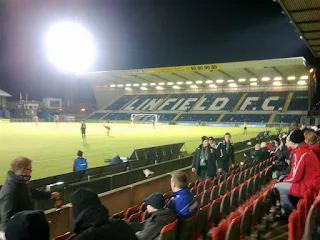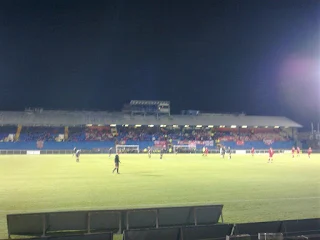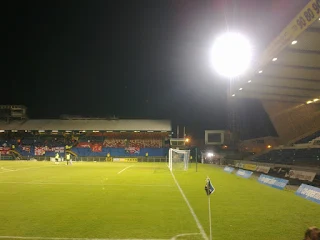Linfied FC is a professional football club formed in 1886 in Belfast by workers at the Ulster Spinning Company's Linfield Mill. The Blues started out playing behind the mill works at The Meadow, having been formed in Sandy Row in South Belfast, where the team delivered the Irish League title in 1890-91, 1891-92, 1892-93, 1894-95, 1897-98, and 1898-99.
They then moved to a new home on Ulsterville Avenue. Linfield also lifted the Irish Cup several times throughout the decade, with three consecutive victories between 1890-91 and 1892-93 as Ulster were defeated 4-2, which was backed up with a 7-0 win against The Black Watch and then a 5-1 victory over Cliftonville.
Bohemians were hammered 10-1 in 1894-95 before the Cup was lifted in 1897-98 with a 2-0 win over St Columb's Hall Celtic before Glentoran, who would become bitter rivals, were defeated 2-1 twelve months later. Early goalscoring heroes at the club included Robert Hill, Tim Morrison, Michael McErlean, George Gaukrodger, Joe McAllen, Johnny Darling, and Richard Peden.
Further honours continued to be won while in residence at Ulsterville Avenue. The Irish League title was secured in 1901-02 and 1903-04, while the Irish Cup was lifted in 1901-02 with a 5-1 win against Distillery before Derry Celtic were defeated by the same score in 1903-04, before Linfield purchased some land off Windsor Avenue to create Windsor Park.
The inaugural game at Windsor Park against Glentoran, although Belfast Celtic were their main rivals at the time. The Irish FA signed a long-term lease at Windsor Park to play their international home games at the stadium. A further hat-trick of league titles arrived at Windsor Park between 1906-07 and 1908-09.
Further championships were added in 1910-11 and 1913-14. The Irish Cup was awarded in 1911-12. Glentoran were beaten 2-0 in 1912-13, Belfast Celtic were seen off 1-0 in 2014-15 before a replay win over Glentoran the following season. The Cup returned to Linfield in 1918-19 with another replay win against Glentoran.
The following decade saw further Irish Cup triumphs following 2-0 wins against Glenavon in 1921-22 and then Glentoran the following season. The same victorious seasons were added to with Irish League titles before Linfield were crowned as national champions once again in 1929-30, with Joe Bambrick the star of the show after being signed from Glentoran.
The final decade before World War II saw Linfield win the Irish League in 1931-32, 1933-34, and then for an eighteenth time the following season. Meanwhile, the Irish Cup was won regularly. Ballymena were defeated 4-3 and then 3-0 in the finals of 1929-30 and 1930-31.
Cliftonville were thumped 5-0 in the 1933-34 final, which was followed by a 2-0 replay win against Derry City in 1935-36. Ballymena United were defeated 2-0 in 1938-39, before 3-1 and then 4-2 triumphs over Glentoran in 1941-42 and 1944-45, before Distillery were defeated in 1945-46.
The 1947-48 final saw Coleraine overcome 3-0 at the nearby Celtic Park on Donegall Road, home of Belfast Celtic, which shared the final with Windsor Park at the time. Celtic would be very much in the headlines in the following twelve months.
Linfield have always been depicted as a staunch Protestant club, and it was in no small part the actions of their fans that led to Belfast Celtic FC disbanding. On Boxing Day 1948, at the annual Linfield v Celtic game at Windsor Park, the visitors were winning for most of the match until Linfield equalised in the last minute.
Linfield fans invaded the pitch and attacked several Celtic players, including centre-forward Jimmy Jones, who suffered a broken leg. Belfast Celtic decided that enough was enough after that incident and disbanded at the end of the 1948-49 season. Without one of their major rivals in the way, Linfield won the Irish Cup in 1949-50 with a 2-1 win against Distillery.
They then lifted the trophy for a twenty-sixth time with a 5-0 victory against Coleraine in 1952-53. The league title was secured in 1949-50, then three consecutive times from 1953-54 to 1955-56, and then again in 1958-59 after Jackie Milburn had been appointed as player-manager as he finished league top scorer on a couple of occasions as his team also won the Irish Cup 5-1 against Ards in 1959-60 before his departure.
Isaac McDowell took over as manager to lead the side to league titles in 1960-61 and 1961-62, with the latter success being added to with the Cup as Portadown were defeated 4-0. Tommy Dickson took over as player-manager to lead his charges to the Irish Cup win in 1962-63 as Distillery were defeated 2-1.
Sammy Pavis provided the goals as Linfield became league champions for a twenty-seventh time in 1965-66. The club had played in European football on several occasions, but the 1966-67 season would see their most notable achievement. Victories against FC Aris Bonnevoie of Luxembourg and the Norwegian side Valarenga were dispatched before CSKA Sofia ended their run, as Linfield reached the quarter-final of the European Cup.
Ewan Fenton led the team to the Irish League title in 1968-69 before lifting the Irish Cup the following season as Ballymena United were overcome 2-1. International star Bryan Hamilton led the way as Linfield won the league in 1970-71 before he was signed by Ipswich Town. A period of lesser success followed as other clubs caught up while Linfield went through a succession of managers.
Billy Campbell led the team to the Irish League title in 1974-75 before the appointment of Roy Coyle, who would remain in situ for the next fifteen years. After a steady start, he led the team to a consecutive hat trick of league titles between 1977-78 and 1979-80, with the first and last triumphs doubling up with a 3-1 Cup final win against Ballymena United and then a 2-0 success against Crusaders.
A 2-1 Irish Cup final victory over Coleraine followed in 1981-82, which coincided with the first of an unprecedented five consecutive Irish League titles right through until 1986-87 for Coyle’s magnificent outfit as Martin McGaughey and Trevor Anderson terrorised opposing defences. The inaugural League Cup was also collected in 1986-87 as Crusaders were beaten 2-1.
The league title returned for a fortieth occasion in 1988-89 as Stephen Baxter led the scoring. Coyle would end up helping Linfield to a staggering thirty-one trophies during his stint, including eleven championships and five Irish Cup wins.
In Coyle's final season, a dark reminder of crowd trouble and sectarianism reared its ugly head in an Irish Cup tie at Windsor Park against the Blues' latest Catholic rivals, Donegal Celtic. To see the frightening scenes, click here.
In the interest of balance, click on the link below to see the good side of the club as they win the Irish League in dramatic circumstances on the final day of the 1993-94 season after the club had been crowned champions the previous season under former player Anderson. Unbelievably, a decisive result in the match between Glenavon and Portadown would have won the league for either side.
Portadown drew while Linfield beat Glentoran to sneak through and lift the title, which can be seen here. Linfield had lifted the League Cup in 1991-92 when Larne were defeated 3-0. The Irish Cup was also won for a thirty-fourth time in 1993-94 following a 2-0 win against Bangor, as well as the League Cup with a 2-0 win over Coleraine, before the Irish Cup was retained twelve months later when Carrick Rangers were defeated 3-1.
After a quick bit to eat, a siesta, and a welcome warm bath after an open-topped city tour and a ride out to Solitude, the home of Cliftonville FC, I set out for the match, but only after some much-needed refreshment. I called in to one of the most famous pubs in Ireland, called the Crown Liquor Store.
It is still in the same layout as it ever was, with private booths and bells to ring for service around the walls. The staff were immaculately decked out. Another pub, Robinson’s, was next door, so I checked that out for future reference. Then it was over the road to Great Victoria Street Station to catch the train to Adelaide, nearby to Windsor Park.
We passed the stadium and kept going for a while, which slightly concerned me, especially when only one other passenger crossed the bridge towards the ground. I asked him if I was heading the right way, and he seemed astonished I’d want to go to such a game when Sky were showing an English match.
Where these stands now stood, used to be terracing, open behind the goal, and with a roof over part of the side. In the 1950’s the ground could accommodate an amazing 60,000 fans, which would pack in for Home International games against England.
The gate was estimated to be around 1,900, but for some reason, cup attendances are never published. My train back wasn’t for 20 minutes, so I decided to walk back into town, feeling certain that other Glens fans would do the same, as they are a Belfast club. How wrong I was, and before long, I seemed to be the only person outdoors.























No comments:
Post a Comment